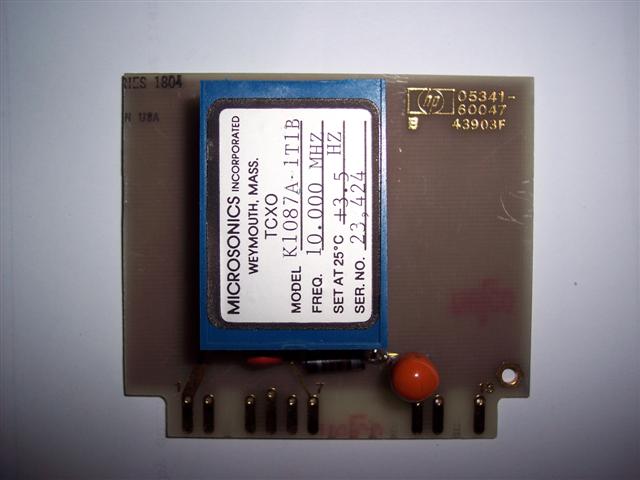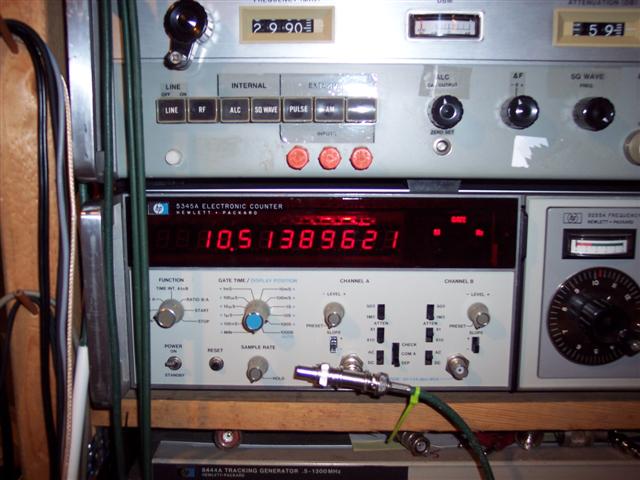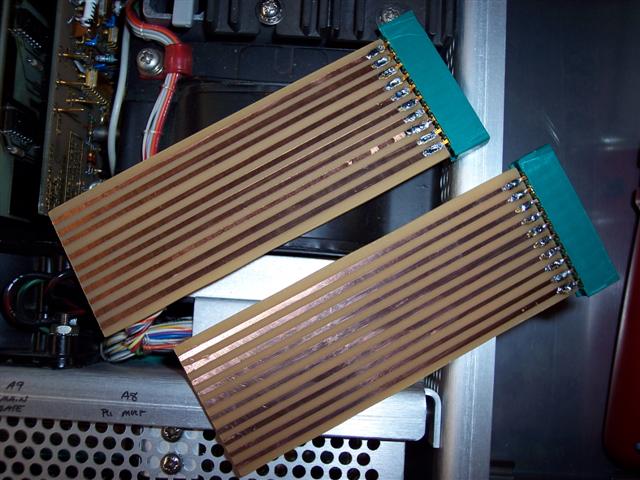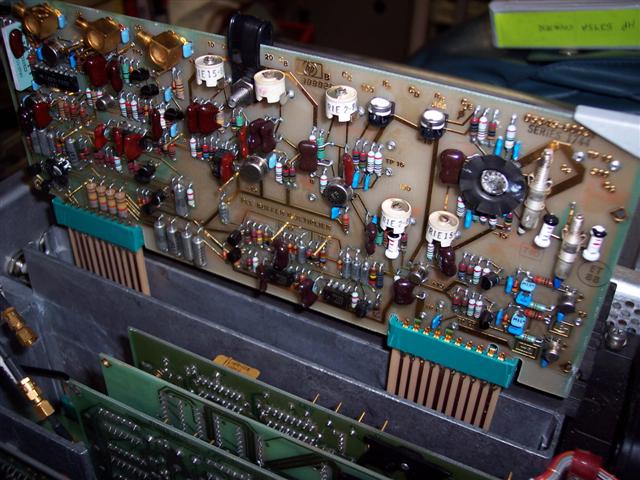(Caution: this narrative is an adventure in awkward English.)
Every ham will probably acquire a frequency counter at some point in their hamming. I am the lucky owner of not one, but three HP5345A counters.
The HP5345A is a 50μHz - 500MHz counter. It is a reciprocal-taking counter, so it measures the period of the signal and inverts to get the frequency. Combined with some other techniques, allows for very good accuracy, even on pulsed signals. The unit is at least as old as I am. This model was featured in the June 1974 HP Journal. Interesting reading. (One of the designers mentioned in the articles is a UW alumnus.)
My unknowing collection of the 5345s started in the summer of 2006 at the South Milwaukee hamfest. Some guy (who looked a bit like Santa Claus) had a bunch of HP equipment for sale, among those were two HP 5345A counters. These counters are 0-500 MHz counters, and included a HP10590A adapter for some converter plugins -- a HP 5254B .2-3GHz converter and a pair of HP 5255A 3-12.4GHz converters.
The guy said one didn't work, it was for parts. Or maybe he said it worked, I don't remember. I think I talked him down to $75 for the pair.
One catch -- neither had an oscillator installed. He did have one in his truck that went with the counters. When he went to fetch the oscillator, I asked if he'd install for safekeeping in the working unit. He obliged.
Turns out the oscillator he had for this unit, a HP 05341-60047, albeit a 10MHz TCXO, didn't exactly fit the 5345. Just a little too wide. He claimed that all I'd have to do was cut it down a little -- maybe 1/8" -- narrower and it'd be just fine. Well, he had a deal -- but for $50 now.

Pricing for this item in 1974 was $3450.
At home I checked out the pinout. Seemed OK -- 10MHz at pin 1, etc. I desoldered the TCXO and sacrificed a steel blade in my scrollsaw to the cause. After I reinstalled the TCXO, I installed the newly-narrowed board in the 5345. The counter seemed to work just fine, I guess. Eventually I built a 10MHz reference oscillator and hooked it up.
 Problem is it reads a bit high.
Problem is it reads a bit high.
I did a lot of board swapping between the two counters. Using the HP service manual, I pared the problem down to A8, the PLL board. That was about as far as I went -- after all, I could use the 10MHz reference to make the counter work -- with 10MHz on the A channel, using the B/A function, just multiply whatever it says by 10 and call it good.
But that seems like a hack.
Sometimes I can leave well enough alone. This wasn't one of those times. Having zero to lose, I started tweaking some of the caps on the PLL board. Amazingly, the frequency came down and started to read right around 10MHz! The check function did not work. It did lock. Once. When I had that, I put the lid back on and put it in my rack. Didn't lock twice.
That lead me to thinking I should make a real attempt to tweak A8 into either oblivion or functionality.
What I needed was an extension card to get the A8 PLL board out of its slot so that I could probe it with an oscilloscope. HP of course made one years ago. I doubt I'll ever see a real one, so I made my own. I found that Jameco had Cinch connectors with 0.156" pitch -- an identical match for the unit.
 These are my own extender boards. I used packing tape as an etch resist.
Not the prettiest, but heck, they worked!
These are my own extender boards. I used packing tape as an etch resist.
Not the prettiest, but heck, they worked!
HP, er, I guess Agilent is quite the company. Need a manual for a 33-year old piece of equipment? It's probably on their website. Most companies would deny having ever made hardware that's more than a few years old. Want a service manual for some new hardware? Forget it. (Probably doesn't exist.)
HP manuals are impressive. Everything you need to service the hardware such as circuit descriptions, flowcharts, schematics, all in one spot. They're even in the English language! Armed with the calibration procedure and schematic, I was able to trace the 10MHz signal through the amplifiers, doublers, multipliers and so on to tweak the caps to where the level ought to be.
But first -- what 10MHz signal? I verified that my 10MHz TCXO plugin worked outside of the unit. Apply +5, you get 10MHz out. I couldn't find that same signal on the PLL board. Turns out the 05341-60047 is not quite pin compatable with the HP5345A. The counter doesn't supply +5 on pin 7 like this TCXO wants. It also grounds the EFC signal. This explains why the 10MHz didn't exist. What I don't understand is how it ever worked at all, even incorrectly! This may explain why that board was just a little too wide for the HP5348A. It didn't belong in there.
It should also be noted that the HP10811-60111 is an OCXO -- a high-stability upgrade for the original board designed for the 5348A. The low-end board is a TCXO. Designed for what, I don't know.
I made a quick adapter (PC board stub) to run the output of my 10MHz low-pass filter directly in where the frequency standard should go. Success! I was able to tweak *both* A8 PLL boards into spec while mounted on their homemade risers.
So, I now have a counter that just needs an oscillator, and one for parts -- due to a bad ROM board and that may be only for a lack of time to troubleshoot that part.
I may modify the weirdo TCXO that I have to make another working counter that will rely upon being locked by an external reference. Or I may buy another HP18011 and sell it as a working unit. Not sure if I can make my money back. I'll have to watch the ebay auctions and see about that.
Doesn't end there, though.
Watching ebay, I found another HP5345A for sale, this one with a 5354A converter. The buyer didn't/couldn't test it. They tried when I asked, but you really need to have all of the switches and knobs in the right spot to do a test. I won the auction for $99. This was when I still had two less-than-functional 5345As at home.
Friday last, a dirty and dusty counter arrived in my office. I opened the lid, and to my surprise found a HP10811 instaled in the oscillator socket! That was worth my initial outlay right there. On power-up, with the switches and knobs all set correctly, the 100MHz "check" function worked right away. Further testing at home revealed a fully-functioning counter. And an excuse to either fix or break my other counters.
So, are two counters plus spare parts enough? Only time can tell.
Mon Apr 28 09:01:36 CDT 2008
I just found A HP5345A board extender kit on ebay -- the seller wants $199 plus shipping for the boards. Glad I've now seen one.
Mon Jul 18 23:07:58 CDT 2011
I also have a HP5354A .015 - 4GHz automatic plugin converter for my counter. Has never quite worked. Found the manual on the Agilent website, poked around a bit and just kinda forgot about it. Finally needed to be able to count above 500MHz for my transverter boards. Decided to poke some more. Figured I might find the input mixer was dead. Nope. Oddly, no oscillator output was present at the mixer input. Found one of the oscillator boards had, of all things, a COLD SOLDER joint! Fixed that. Closer but not quite. Found that there are three "qualifiers" to determine if a signal is valid. The signals were fed to the input of a 4-input NAND gate. The output of that gate didn't make sense. Hard to probe that board so I just ordered replacement chips for everthing on that board. For less than $4 it wasn't going to break the bank. Sure enough, replaced that NAND gate and it started working! Amazing!
| model | description | notes |
| 5353A | Channel C module | 0-500MHz |
| 5354A | .015 - 4GHz automatic plugin | |
| 5355A | 400-1.5GHz | 5356C head to 40GHz |
| 5356A | 1.5-40GHz | needs 5356A/5356B/5356C heads for 18/26.5/40GHz |
| 5358A | measurement storage | GPIB |
See also Brooke Clarke's HP 5345 Counter page.
This page last modified Mon Jun 5 09:02:51 CDT 2023 by timc!
